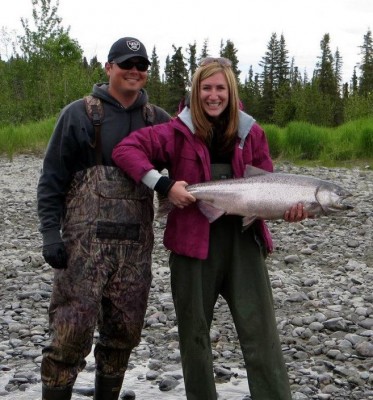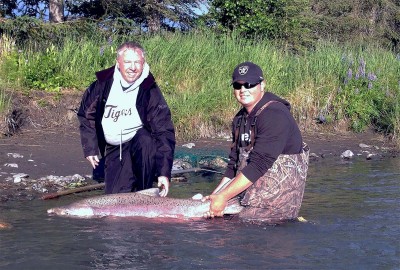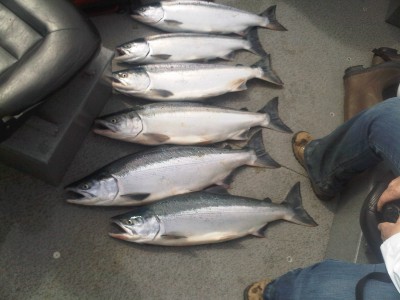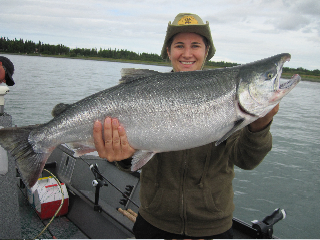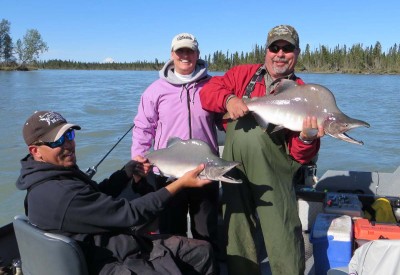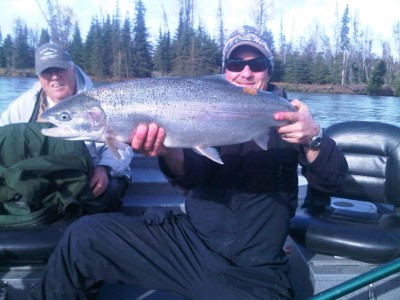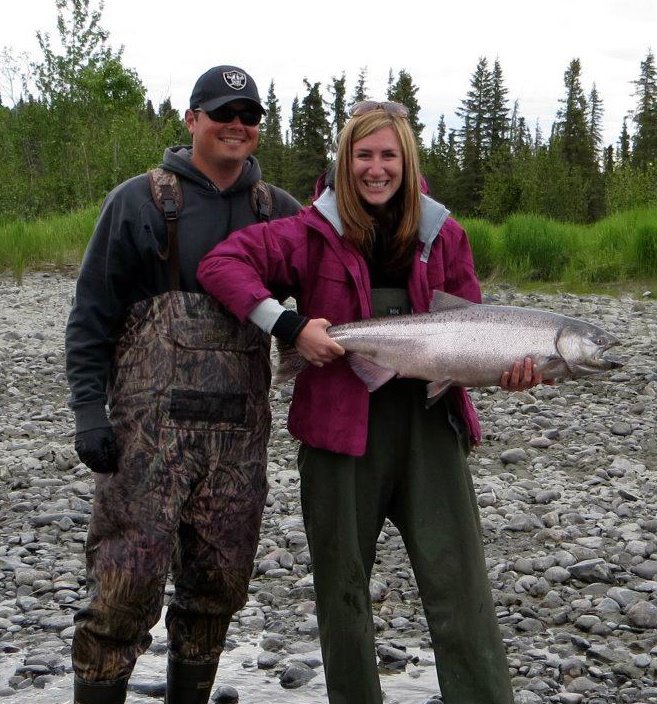
09 Jan Alaska Fishing Reports: 2012
2012 Year in Review
As I look back on the highs and lows of this past fishing season, it becomes obvious that the lows definitely outnumber the highs. Perhaps the most disappointing was the low returns of king salmon, not just here on the Kenai River, but across the entire state of Alaska. Highs and lows in salmon returns have been happening for eons so these cycles do happen but we will certainly look forward to more abundant king salmon numbers in the future.
We began by drifting the Kasilof river in mid May and had a number of very successful days where we saw multiple kings come to the net. This is normally what we can expect just before fishing gets really good for that week to ten day peak in early to mid June. Unfortunately, this season just did not see a peak to the early run of king salmon on either the Kenai or the Kasilof. Eventually the low returns prompted managers to restrict both rivers to catch and release only in mid June and then to an eventual closure for all king salmon fishing on June 22. Needless to say the early run of king salmon was a roller coaster ride and we did a great deal of rescheduling for alterative species and “Plan B” locations to make sure people had plenty of fish to catch and also to take home.
As June faded into July we remained cautiously optimistic the king salmon woes would end with the early run but this was not to be as the late run started at the same sputtering pace as the early run. Managers already anticipated the late run would be lean and they began the July 1 season opener with no bait restrictions and then soon moved to full catch and release fishing on July 8. Eventually on July 19, both the Kenai and the Kasilof were closed to all fishing for king salmon and the 2012 king salmon season ended on this solemn note.
Despite the overall disappointment in the 2012 king salmon season, there were some aspects to the season that were uplifting and positive, giving hope that in the not so distant future our king salmon stocks will rebound. One saving grace was the willingness of Alaska Department of Fish and Game to limit July set net fishing in the face of a large sockeye return. Despite sockeye salmon numbers exceeding in river escapement goals, the department held firm in not allowing east side set nets to fish as along with the sockeye, this fishery is very effective at intercepting Kenai and Kasilof bound kings. The beaches along Cook Inlet, where normally hundreds of set gill nets await the fish as they return from their sojourn at sea, was left wide open. This, along with the in-river restrictions, allowed safe passage for the kings that did return.
While certainly disappointing from an angling standpoint, conservation wise, we wholeheartedly supported the restrictions of this past summer. We know that these sacrifices helped ensure that most king salmon possible were able to spawn. Floating over their spawning waters in the fall while trout fishing showed ample numbers of king salmon did successfully complete their journey and we are all very hopeful our world renown king salmon runs will continue to rebuild.
With king salmon fishing so limited this summer, we were fast at work finding alternative fishing experiences for our guests and by far the most productive was sockeye. With well over one million fish making it into the river, the run was above average and fishing success reflected this obvious abundance. For many days in a row in mid to late July, well over 50,000 sockeye were flooding the river mouth daily and like clockwork, they would pulse through our favorite fishing water in masses. With the limit upped to six fish, we routinely headed in after successfully catching our four person limit, with an average of 100 lbs… of filleted sockeye. This was a welcome alternative to the king closures and for many the satisfaction of wade fishing and actually flipping, hooking and landing the fish entirely on their own was very satisfying. For those that had never experienced the sheer power sockeye salmon possess, I think most were amazed at how much fun they are to catch. Despite often landing a limit in a few short hours, getting six feisty sockeye to the net is not a relaxing affair. It involves a great deal of hard fighting action and that’s really what fishing is all about.
The strong run of sockeye salmon kept us busy well into the first week of August when the first reports of silvers and pink salmon began filter in from the lower river. By mid month we had transitioned entirely to silvers, pinks and trout.
We first targeted the silver salmon in the lower Kenai and then followed the bulk of the run upriver as the month progressed. The overall silver return was only average yet the pink salmon run seems much like it has been in the past two even year cycles…huge! The millions of pinks can make it tough when targeting silvers and trout, as they are just so numerous they become impossible to avoid. Nevertheless, even thought they did slow the silver and trout action some, they were still fun to catch. After all…, it’s tough to complain about catching too many fish!
The effects of the huge run of pink salmon carried over well into fall as this is when we can normally expect some of the best trout fishing of the season. The bite was slower overall this year, primarily because the fish were gorged with food. Virtually the entire river bottom was one patchwork quilt of pink salmon eggs. Millions upon millions of unhatched protein pellets rolling aimlessly along the river bottom. For the trout, they need not move more than an inch to find as much food as they need. It became tough to gain their attention with a plastic bead painted to imitate the real thing. The result was fewer numbers but when you did fool one, it was guaranteed to be well fed, hard fighting and heavy.
The late run of silver salmon was much like the early run, just average. That said, there were plenty of fish for those willing to put in their time and even well into October limit catches of fresh coho were being reported. Trout fishing eventually improved considerably, largely following a high water event that washed away much of the loose pink spawn and carcass meat. Time on the water was limited this fall as frigid winter temperatures gripped the Peninsula earlier than normal this year. Forecasters called it the coldest November on record for the past 100 years. Soon the majority of the Kenai was covered in ice, resembling more of a Martian moonscape than a river.
As we look forward to 2013, we do so with a certain cautious optimism that our king salmon runs will once again rival any in the world. However, the realist in me knows our process of restoring the historically highest levels of king salmon to the mighty Kenai and Kasilof will be an ongoing effort involving sacrifice and change both in the marine and inriver environs. Changing our view of king salmon as table fare or as a harvest species is easier for some than others but this will be integral to their preservation. They cannot be placed in the same category as sockeye in terms of harvest as they are just not as plentiful and far more genetically unique..
For myself, this an annual opportunity to genuinely thank everyone that fished with us this past season. We know many were disappointed with not being able to fish for king salmon but we were extremely proud of all our guests as they understood the importance of conservation. We appreciated all that were flexible and took advantage of the huge sockeye run, trout fishing, fly outs, etc…in lieu of the king salmon restrictions. We enjoyed introducing many of you to new and exciting methods and species and we know our contribution to king salmon conservation will be rewarded.
Next year is yet another run and a whole new realm of possibilities. We always look forward to a new season and the wealth of experiences it will bring. This will be our 23rd consecutive season and while each year is always different one thing has always remained steady: our genuine love for the Kenai River and our hope to see it thrive well into the future. We thank all that have supported us through the years and wish everyone a blessed, fish-filled 2013.
Fish On!
Mark and Cindy Glassmaker
2012 Fishing Reports: August 6, 2012
The remainder of the 2012 King Season was very eventful despite the full river wide closure for king salmon fishing. The sockeye run ended up becoming much stronger than anticipated and this provided a great alternative to king fishing and with a limit of six fish, it also made for some very full fish boxes. Limits were the rule for sockeye all the way until the last few days when the run finally started to wane. This is a normal sign that its time to transition from sockeye to silver salmon. Silvers and Pink salmon have begun showing up in decent numbers in the lower Kenai and a few silvers have been making their way higher up into the waters below Skilak Lake. Trout fishing in the middle river has been as good as we have even seen it and all the fish are extremely fat and healthy after feeding on the abundant socket carcasses that now littler the whole river. We are looking forward to continues success with the newly arriving silver salmon and the trout and all indications pint to a very prolific August.
Fly Out fishing for silver salmon on the west side of Cook Inlet has been very good at times and just OK as well. The tides and weather have played a larger part in angling success though 90% of our trips have been yielding full limits. These runs should only continue to improve as they move toward their annual peak in the next week to ten days.
Fishing Report: July 24, 2012
The statewide king salmon woes for the 2012 season have carried over to the late run. Anticipating an extremely low return, managers began July on both the Kenai and the Kasilof Rivers with unprecedented no bait restrictions and soon thereafter went to catch and release only fishing beginning July 8. On July 19, the Kenai and the Kasilof were closed to all fishing for kings and will very likely remain closed for the remainder of the season. While these management actions have certainly been tough to swallow for visiting anglers, it is important to point out that the Alaska Department of Fish and Game is doing the right thing by being proactive in their conservation of these important king salmon stocks. They have also severely restricted the East Side set net fishery and this has allowed the few kings returning safe passage to the river.
Despite the lack of king salmon abundance, we have seen a very healthy return of sockeye and this has kept the fish boxes full and smiles on our customers faces. The sockeye this season have been very large on average and fishing has been rated as excellent. The limit is now six fish as well so this is a great opportunity to fill the freezer with the best salmon in the world. They have been ferocious fighters and action has been steady and very exciting. This has provided a very viable option to the king fishing and all have been very satisfied with their time on the water.
Halibut fishing in nearby Cook Inlet has also remained very good and limits of 20-70LB halibut have been the rule.
We are just beginning to see the first silver salmon arrive in our fly out trip to the west side of Cook Inlet and this will continue to improve over the next week to ten days.
Fishing Report: July 1, 2012
Early run king salmon returns on both the Kenai and the Kasilof Rivers ended up much lower than expected and it is doubtful either river will make its escapement goals. The low returns prompted ADF&G to restrict both rivers in late June. On June 22, the Kenai river was closed to all fishing for king salmon. The Kasilof was also restricted on June 22 to no bait and single hook. Both rivers will re-open today, although restrictions will remain in place including no bait and single hook on both rivers, and no fishing for king salmon on the Kenai river above Slikok Creek.
Due to the low abundance of king salmon statewide and the uncertainty of how strong the late run will be, we will be strongly encouraging all of our July anglers to release all kings we catch. We certainly understand that some will be unwilling to let their “fish of a lifetime” return to the river BUT nevertheless we will do our best to educate and encourage them on the importance and dignity associated with releasing these magnificent animals. If we all do our part, it is hopeful the Kenai river will one day return to its former glory. For those interested in doing one step more to help the Kenai and it embattled kings, here is an information sheet I assembled with fellow industry leader to give people the necessary information to voice constructive concern to the managers and state officials charged with protecting our fisheries for future generations. Please take the time to reach out, even if it’s simply a one sentence letter or email. Every voice and message will help and is greatly appreciated.
Sharing the burden of conservation:
Saving our Cook Inlet King Salmon resource
As we are all well aware, this season’s returns of king salmon to the Kenai and the Kasilof Rivers as well as all other rivers throughout Cook Inlet may be the lowest ever recorded. Not only are returning numbers of fish so low that sportfishing has been prohibited on many watersheds, it may be so low that it actually threatens the sustainability of these stocks well into the foreseeable future. Can anyone envision Alaska without the magnificent king salmon that have returned to our coastal bays and rivers for centuries?
Whether you are a week-end warrior, a casual sport angler, a guide, a local business owner or even just a parent of a young person that might one day hope to experience the thrill of catching a king salmon on rod and reel, you should understand that the time is now to accept and shoulder the burden of conservation to ensure these important fish do not disappear from our ecosystem.
As many are aware, in-river restrictions this season have been widespread and severe:
•-The Kenai River was closed to all fishing for king salmon starting on June 22.
•-The Kenai River late run will begin with no bait on July 1. This is the first time this has ever occurred and will result in at least a 50% reduction in harvest.
•-The Kasilof River has been restricted to no bait and single hook until July 1, reducing catch rates by up to 90%.
•-All king salmon sport fisheries in the Susitna Drainage have been closed to all fishing through July 13.
•-Kasilof sub-district and Upper Cook Inlet set gillnets were closed by emergency order on Monday, June 25 but may be allowed to fish their regular openings on Thursday June 28 despite king salmon abundance levels for the Kenai and Susitna Drainages tracking well below average and the increasing likelihood that escapement goals will not be met Inlet wide.
•-Despite these sacrifices in-river and the dramatic effect this has had on our local economies, commercial fishing may still be allowed to fish their regular openers and possible “emergency openers”.
Important facts about sportfishing, our local economies and commercial fishing:
•-Sportfishing yields nearly 1.4 Billion dollars for the State of Alaska.*
•-Sportfishing yields some $720 million dollars for Cook Inlet alone.*
•-The estimated population of the Kenai Peninsula is 60,000 people.
•-The State of Alaska sold 171,399 king salmon stamps in 2011 for a combined revenue of 2.8 million dollars.
•-In 2012, there are 570 commercial drift gillnet permits in Cook Inlet.
•-In 2012, there are 730 commercial set gillnet permits in Cook Inlet.
Important facts about ADF&G management of king salmon in Cook Inlet and the Kenai and Kasilof Rivers
•-Enumeration of Kenai King salmon via split beam sonar technology has been proven less accurate than current Didson sonar and many past management decisions have been based on inaccurate data.
•-The escapement goal of 5,300 to 9,000 early run Kenai River King Salmon is too low to sustain itself in years of low abundance and needs to be raised.
•-Alaska Department of Fish and Game continues to run in-river test netting programs to enumerate and study Kenai and Kasilof King Salmon despite proven high levels of mortality associated with these programs.
•-Alaska Department of Fish and Game has continued to use restrictions in-river as the primary management tool to bear the burden of conservation while still allowing excessive commercial set gill net fishing to occur on the East Side of Cook Inlet: despite not being certain in-river escapement goals are being achieved.
•-Alaska Department of Fish and Game should join the fight to stop excessive by catch of Alaska bound king salmon in both the Gulf of Alaska and the Bering Sea by commercial trawl and pollock fisheries. According to a report by the North Pacific Fishery Management Council, from 1990 through 2001, the Bering Sea Chinook salmon by catch average was 37,819 salmon annually. Since 2002, chinook salmon by catch numbers have increased substantially. The average from 2002 to 2007 was 82,311 Chinook salmon, with a by catch peak of 122,000 chinook salmon in 2007.
The time to act is now!
If you think you are powerless in this time of crisis, you are wrong. Your voice and your vote is the most powerful tool in this entire process. Our Governor and our state legislators need to hear from YOU, THE CITIZENS OF ALASKA as your voice and your vote is the direct connection to them being elected and retaining their job. Please act today not only on behalf of the resource but ultimately for all the small business owners, all the citizens of Alaska and the United States and ultimately for future generations so they too can see our formerly prolific salmon runs restored to robust and sustainable levels.
Please contact by phone, email or mail any and all of the following people and voice your own personal concerns on this timely and important topic. Remember, tomorrow may be too late!
Governor:
Sean Parnell
sean.parnell@alaska.gov,
https://gov.alaska.gov/parnell/contact/email-the-governor.html
ADF&G Commissioner: Cora Campbell
dfg.commissioner@alaska.gov
Division of Sport Fisheries
Director
Charlie Swanton (907) 465-6184
charles.swanton@alaska.gov
Regional Fisheries Management Coordinator (Cook Inlet)
Tom Vania (907) 267-2131
tom.vania@alaska.gov
Division of Commercial Fisheries
Director
Jeff Regnart (907) 267-2350
jeff.regnart@alaska.gov
Board of Fish members:
Board of Fish Executive Director
Monica Wellard
monica.wellard@alaska.gov
* Economic impacts and contributions of sportfishing in Alaska, 2007 …
https://www.adfg.alaska.gov/static/home/library/pdfs/sportfish/2007economic_impacts_of_fishing.pdf
This study can be found on ADF&G web page and it was done by Southwick Associates, Inc and William J Romberg.
Aside from the poor king returns, we have been seeing great success in other fisheries and have been additionally successful in sending home very happy customers. We feel blessed to have such a great staff and a well diversified business so that even in the tough times for king salmon we can continue to make peoples dream trips to Alaska a reality.
One awesome trip we have encouraged people to take is a fly out to the West Side Of Cook Inlet for sockeye and bear viewing. This has been a very dependable and enjoyable excursion with awesome scenery, great fishing and the chance to see bears in close but safe proximity. We have also been delighting guests with a glacier flight on the way back capping off what most feel in a truly remarkable experience.
Here on the Kenai we have also been doing a lot of trout fishing in the water below Skilak lake and although the water has been off color and the trout have seen a lot of pressure, we have been catching a good number of fish daily. Combined with a trip to see magnificent Skilak Lake, shore lunches, eagle and moose sighting, these have been some very rewarding times on the Kenai River.
On the Kasilof River, we have diverted our king fishing to shoreline fishing for sockeye and have had great results. Recent trips have yielded full limits and awesome scenery. We will continue to offer this great option as the peak of this run should occur in the next week to ten days.
Halibut fishing has remained very productive with 100% limits being the rule. Many thanks to Levi and Hunter Keogh for their continued hard work and excellence in what they do. These are two of Alaska’s finest saltwater guides and we are very proud to send our people out with these true professionals.
Fishing Report: June 17, 2012
The Kasilof River appears to have reached its peak and is now on the backside of its early run king salmon return. Recent tides continue to bring a few fish but any noticeable upswing to fish numbers and fishing success simply did not occur. It appears the run was simply weak this year and at time when we are normally hooking multiple fish per day, we are currently only averaging 1-2 fish at best. We are also seeing some jack kings and sockeye. Due to the low return, an emergency order has been issued for the Kasilof allowing only hatchery fish to be retained. No wild or naturally produced kings may be retained on the Kasilof river through June 31.
The Kenai River fished pretty well this past week although managers did issue an emergency order closing the river to all retention of king salmon and currently only catch and release fishing is being allowed. This is due to a lower than average return, currently the lowest on record. Water conditions have been marginal due to heavy rain 3-4 days ago but water clarity is getting better daily. The river is no longer low and is now flowing at or slightly above normal levels for this time in June. This past week our boats averaged 1-4 kings per trip. On Fri. and Sat. we did need to release all the kings we caught but we did see some very nice fish come to the net. It was very rewarding to see these fish swim away unharmed, as given the low numbers currently in the river, the future of the run is most important. If we do not see a dramatic improvement in the number of fish very soon, further management restrictions will be implemented. This will likely include a complete king salmon closure for the remainder of June.
Trout fishing on the Kenai opened June 10 and the handful of trips we have taken have all been very productive. We are not seeing very many big fish as of yet but we are seeing great numbers. Our boats have been averaging 40-70 fish per trip.
Remote fly out fishing to Big River Lake has been very good and all have been retaining full limits. This should only continue to improve through the end of June as this run continues to build.
Fishing Report: June 6, 2012
Kenai and Kasilof Rivers
The Kasilof remains fairly low for this pint in the season and fishing is best described as slow but steady. A very discernable push of fish is arriving daily on the tides but unless you are in the right place at the right time, action is limited. Our boats have been fortunate enough to pattern this daily wave of kings entering from Cook Inlet and are fishing 8-10 hours for 1-5 fish. Most of the action is occurring in very select holes and locations where the water is deep enough for the fish to stop and the catching is occurring is rapid succession rather than being spread out throughout the day. Being in the right place at the right time seems to be essential to success as with the low water and the limited number of fish, there are not multiple opportunities in multiple locations. We are now in an extremely high tide cycles, not always the best for kings entering the rivers so as this changes to more moderate tides next week, we should see some improvement in numbers. There are an abnormally high number of sockeye salmon present in the Kasilof and we have been consistently catching them on king salmon tackle. It is uncommon for sockeye to regularly bite king salmon gear but for whatever reason we are averaging at least 1-2 sockeye per trip.
On the Kenai, fishing can best be described as OK. The lower Kenai is producing some very nice king salmon daily and again it seems to be mostly around the push of fish coming off the tides. Boats are averaging 1-3 fish. Counts remain well below the historical averages and managers are watching the run very closely. Again we are in a very unfavorable tide cycle this week and next week it will be important for current numbers to improve or restrictions will likely be implemented. This will include a step down to catch and release and if this does occur on the Kenai, the Kasilof will also be restricted to retention of hatchery fish only. We remain optimistic that the runs on both rivers will ramp up dramatically in the next week to ten days but it is important for anglers to understand all possible scenarios given the current circumstances.
Remote Fisheries
Big River Lake remains very low but we did get motors on our boats over there a few days ago and found very high numbers of sockeye salmon present throughout the river and into the lake headed for Wolverine Creek. After a below average return last year, it seems the run is showing signs of being much stronger this year. Once water level rises and the fish feel more comfortable entering the clear water of Redoubt Bay, fishing and bear viewing around Wolverine Creek should be very good.
Salt Water
Cook Inlet continues to produce limit catches of good eating size halibut and an occasional king salmon for those willing to put in the time trolling. Even with the very high tide cycle right now, fishing for halibut remains steady and consistent and as always this is a great way for visiting anglers to ensure they take some great fish home for the table.
Fishing Report: May 25, 2012
Well, its official. The 2012 Alaska Fishing season has arrived. As usual we have started the season pursuing both king salmon and halibut in nearby Cook Inlet and also king salmon on the Kasilof River. Both of these fisheries have seen success so far with the salt water option obviously being the more predictable pursuit. Both trolling for king salmon and bottom fishing for halibut have been very productive with some nice early season limits being recorded. Trolling for king salmon has yielded some decent action for the relatively few boats on the water although the majority of the fish have been smaller, feeder kings. Captains are noting a lot of baitfish in the Inlet and this is attracting schools of hungry kings to this near shore fishery. Halibut fishing has been its usual predictable self with essentially 100% limits of good eating size flatfish ranging from 15-50 lbs.
While still relatively early for the rivers, we have taken several trips on the Kasilof with consistent yet limited success. The river remains relatively low and clear and water temperatures are definitely colder than normal. This is likely the result of our above average snow pack this winter. As most of the snow melts away and we start seeing warmer temperatures, water temps will likely stabilize and this will definitely improve fishing conditions. Meanwhile boats are working very hard for one or two opportunities per trip. The same holds true for the Kenai River where a number of boats are fishing the lower sections daily with limited success. Like the Kasilof, water temps seem colder than normal for this time of the year and as this improves so should the fishing. Alas, it is still very early to make any realistic predictions regarding overall run strength but as we move past Memorial Day weekend and into the first week of June, we should have a better idea as to what to expect for the remainder of the month
